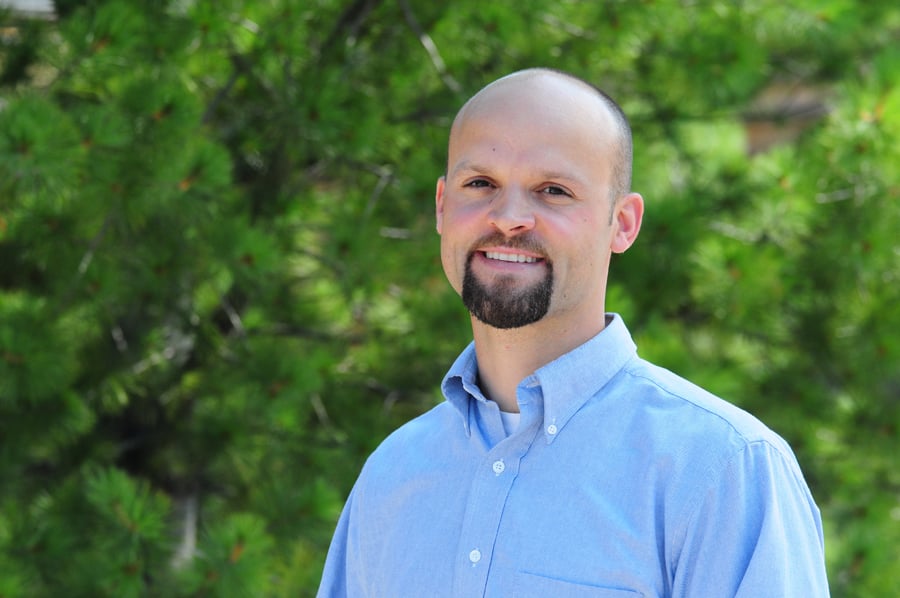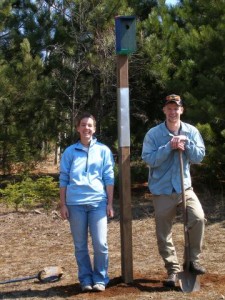Graduate student Brenda Bergman and second year student Ashley Dennis have received a $100 scholarship from the Michigan Alliance for Environmental & Outdoor Education (MAEOE) to attend the annual MAEOE conference in Bay City that will be Oct. 7-9, 2011. Learn more about the Michigan Alliance for Environmental & outdoor Education.
Sean Sobaski has accepted a position as a a procurement forester with PCA (Packaging Corp of America) in Manistee, Michigan.
Sean says, “As a procurement forester at PCA we run a base mix of chips that consist of 70% aspen and 30% hardwood mix.” Sean also comment that because PCA is SFI and SAF accredited and audited, the jobs has witnessed lay rest to his fears that pulp mills take everything and leave nothing. “Most jobs I have been part of consist of TSI treatments, and result in a pristine harvest with reseeding of skid trails and landings after the harvest is complete,” he says.
Sean also praised his education saying, “Its hard to see the knowledge that is needed in this profession when you are attending school, but it’s very rewarding as a forester stick out above the crowd and receive a job such as this!”

The Copper Country Audubon Club has awarded the Dr. Laurence Binford Youth Scholarship fund to Auriel Van Der Larr, a senior majoring in Wildlife Ecology and Management. This award will help support her travel to the Wildlife Society Conference this fall on the big island of Hawaii where she will present her work on determining the gender of Virginia Rails through statistical modeling.
Auriel is pictured on the left with other Bird Bum members Michelle Kroll and Kevin King.

Richard (Rick) Judd visited all the way from San Antonio, Florida in June to “check out all the changes” at Michigan Tech and the School of Forest Resources and Environmental Science.
Rick was joined by his wife Karilyn. Rick says, “My lovely wife of 45 years was the one who put me through college and is responsible for me graduating from Michigan Tech in 1969.”
| Assistant Professor John Vucetich and Research Professor Rolf Peterson contributed to “Great Lakes National Parks in Peril,” a report released Wednesday by the Rocky Mountain Climate Organization and the Natural Resources Defense Council. The report fingers climate change as a cause for the slump in Isle Royale National Park’s moose population and the subsequent decline in the number of wolves. The report is available park. |
| The Forest Resources and Environmental Sciences Teacher Institute, is being held Monday June 27 through Friday, July 1. The 22 participants, coming from all over Michigan to Ohio, Wisconsin and Virginia, are here to learn about a resource of the UP–its expansive forests.
Now in its sixth year, the institute is sponsored by the School, with a grant from the Michigan Forest Foundation. The course is taught by Tech faculty, natural resource professionals and expert teachers. The course is coordinated by Joan Chadde of the Center for Science and Environmental Outreach. |
by Jennifer Donovan, director of public relations
Often touted as the greatest environmental achievement of the 20th century, the North American Model of Wildlife Conservation is anything but, according to wildlife ecologists and environmental ethicists from Michigan Tech and Michigan State University.

Writing in the Summer 2011 issue of the journal, The Wildlife Professional, John Vucetich and Joseph Bump, Michigan State’s Michael Nelson, and Canadian environmental scientist Paul Paquet call the North American Model of Wildlife Conservation seriously flawed. The commentary is the first critique that the North American model has faced.
This model has been around as an idea for about a decade, and in that time it has become quite popular among some wildlife professionals. The model consists of two related approaches to conservation: a historical description of past conservation efforts and an ethical prescription for the future. “One rests upon an inadequate account of history and the other on an inadequate ethic,” Vucetich and Nelson say flatly.
The model’s misconception of history gives recreational hunters the sole credit for preventing the ravages of wildlife exploitation caused by commercial hunting in the 19th century. It cites the efforts of famous hunters such as Theodore Roosevelt.

“Recreational hunting was only one of several important factors that led to improved conservation in North America,” the authors say. Since the 1960s, they point out, conservation efforts have been led by non-hunters and nature enthusiasts, such as national park visitors and bird-watchers.
The historical narrative crediting recreational hunters with spearheading the drive for wildlife conservation in turn becomes the rationale for a belief that recreational hunting is necessary for wildlife conservation. Then that becomes a prescription for future conservation efforts.
The entire construct is misguided, say Nelson and Vucetich. “The principle of past behavior is not, by itself, an appropriate justification for future behavior,” they explain. “Would you argue that society should perpetuate slave labor or gender discrimination simply because such practices are part of our history? Likewise it is wrong to conclude that hunting should play a central role in future conservation efforts, simply because it has in the past.”
The scientists also express concern that the interests of recreational hunters sometimes conflict with conservation principles. For example, they say, wildlife management conducted in the interest of hunters can lead to an overabundance of animals that people like to hunt, such as deer, and the extermination of predators that also provides a vital balance to the ecosystem.
Vuetich and Nelson examine the seven tenets of the North American Model of Wildlife Conservation:
-
- Wildlife is held in the public trust.
- Commerce in dead animals is illegal.
- Wildlife use is allocated through law.
- Hunting is an opportunity for all.
- Wildlife may only be killed for legitimate reasons.
- Wildlife is an international resource.
- Science is the basis for wildlife protection.
Consider the tenet that says wildlife may only be killed for legitimate reasons,” the authors observe. “This principle is as basic and appropriate as it is void of useful insight about defining a legitimate purpose. The North American Model provides no further insight about what counts as legitimate,” they note.
The scientists also raise a question about the final tenet, that science is the basis for wildlife protection. “This equates a desire for policies informed by science with science itself determining what policies ought to be adopted,” they say. “Scientific facts about nature cannot, by themselves, determine how we ought to relate to nature or which policies are most appropriate.”
The authors emphasize that they have nothing against hunting. “If the North American Model’s primary motivation was to promote hunting, and even if it did so transparently, the model would still fall short,” they say.
The model’s greatest value, Vucetich and Nelson say, is that it calls attention to the need to confront a more basic question: What is conservation? “All of us should explore whether wildlife management and conservation are the same or whether they represent different, occasionally conflicting goals,” they suggest. “We still need answers for key questions like: What does it mean for a population or ecosystem to be healthy? How does conservation relate to or conflict with other legitimate values, such as social justice, human liberty and concern for the welfare of the individual? Resolving these and other questions could provide a truly meaningful conservation model.”
Copper Country Audubon recently installed six bird houses at the Calumet waste-water treatment ponds about a mile west of Calumet on Hwy M-203. Thanks go to Supervisor Ken Hyrkas and Foreman Tom Buckett for approval and advice where to put the bird houses. The treatment ponds area is a great place for birds; birdwatchers often go there to observe waterfowl and song birds.

Two bird houses were also installed at the Waasa Cemetery. The birdhouses, made by VSI/Goodwill Industries of Houghton, are on eight and ten foot posts. They may be used by tree swallows, bluebirds, wood peckers and flycatchers.
The Michigan Tech Wildlife Club from the School of Forest Resources and Environmental Science assisted in the activity. Copper Country Audubon thanks its many members that provided funds for the project. Thanks are also extended to the municipalities who allow use of their property to h
elp increase bird nesting success in the area. For more information about Copper Country Audubon contact President Dana Richter, dlrichte@mtu.edu, 487-2149.
View more photos: http://www.flickr.com/photos/mtufres/5737272849/in/photostream

